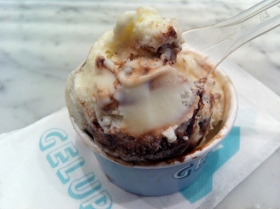The English do a good job with sweets, and this includes desserts, jams, marmalades, and chocolates. The only (non-chocolatey) English candy I’ve had since I was about 10 are Licorice Allsorts, which are quite good as long as they haven’t been sitting on a ghost ship for the past 15 years waiting for just that perfect moment to round the Horn of Africa or passing the time while they put the finishing touches on the Suez canal. Of course the colors will never fade but your teeth will be in danger and the packaging will contain images of by-now immensely unpopular cartoon characters from five years ago, etc.
Don’t buy expensive chocolates at the duty free shops in Heathrow! I did that last summer and then found them to be pale and chalky when I brought them home. Too far a trip to return them, and they actually tasted ok. By all means purchase some of the huge Cadbury’s bars. If you run out of recipients you can store them for the armageddon or play a practical joke on your neighbors and put some on their roof.
*******
There’s a knowing conspiratorial air to the way English people pronounce “banoffee pie”: a sort of breathless evocation of awe and surprise, as if the object in question might also be a species of hedgehog or a famed 14th century illustrated psalter from the British Library. This is in part due to the fact that the object in question is very yummy. And because it sounds as if a Teletubby had named it. It is made from bananas and condensed milk toffee, and I’m sure bears would go crazy for it. Do not bring slices with you to the zoo.
*******
You won’t find banoffee pie at tea. Much too heavy. You will find an assortment of sweets and tiny sandwiches (depending on the level of “Tea” you have purchased, or the amount of prep time you have afforded your friends/relatives). Some of the sweets will be English, others English in emulation of foreign (see English food – part 1). With sweets, as with all else foodie, “English in emulation” (as well as “foreign”) is a positive thing. You can have pain au raisin for breakfast (not the dry kind we so often have in the US), macaroons for tea, Australian rose and almond coconut delight for a snack, or gelato whenever the fancy strikes you. Or you can stay true to your English roots and eat Jojo the rabbit (see image at top) after you’ve finished your Scotch egg and meat pie.
*******
If you fail to tile your neighbor’s roof with giant Cadbury bars you can spruce up their living room with some high-end chocolate boxes. This might actually be a kind gesture as most of the packaging is beautiful; I am particularly fond of Prestat’s vibrant solid colors stamped with gold. The flavors are celebratory and fruity: a bit like a culinary version of Laura Ashley or Cath Kidson, differing, thereby from their American cousins – hard edged complex bars from the Mast Brothers, for instance, wrapped in masculine browns and olives and flavored with salts and chillies. Prestat has a rose and violet creme box, and Rococo chocolates make a marvelous white chocolate and rasperry slabs: Bianco Fragole; its a bit like the difference between Glamping and going on a barebones hike through the Alaskan tundra. English chocolates are meant to be enjoyed, not toughed out, in a relationship to food and pleasure that is less defiant and apologetic. When it comes to sweets few apologies are needed.






